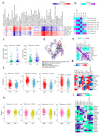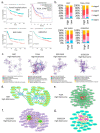The Matrisome Is Associated with Metabolic Reprograming in Stem-like Phenotypes of Gastric Cancer
- PMID: 35326589
- PMCID: PMC8945874
- DOI: 10.3390/cancers14061438
The Matrisome Is Associated with Metabolic Reprograming in Stem-like Phenotypes of Gastric Cancer
Abstract
The extracellular matrix (ECM) is an important regulator of all cellular functions, and the matrisome represents a major component of the tumor microenvironment. The matrisome is an essential component comprising genes encoding ECM glycoproteins, collagens, and proteoglycans; however, its role in cancer progression and the development of stem-like molecular subtypes in gastric cancer is unknown. We analyzed gastric cancer data from five molecular subtypes (n = 497) and found that metabolic reprograming differs based on the state of the matrisome. Approximately 95% of stem-like cancer type samples of gastric cancer were in the high-matrisome category, and energy metabolism was considerably increased in the high-matrisome group. Particularly, high glycosaminoglycan biosynthesis-chondroitin sulfate metabolic reprograming was associated with an unfavorable prognosis. Glycosaminoglycan biosynthesis-chondroitin sulfate metabolic reprograming may occur according to the matrisome status and contribute to the development of stem-like phenotypes. Our analysis suggests the possibility of precision medicine for anticancer therapies.
Keywords: epithelial-mesenchymal transition; extracellular matrix; glycosaminoglycan biosynthesis-chondroitin sulfate; matrisome; stem-like gastric cancer.
Conflict of interest statement
The authors declare no conflict of interest.
Figures




Similar articles
-
Deciphering the Kidney Matrisome: Identification and Quantification of Renal Extracellular Matrix Proteins in Healthy Mice.Int J Mol Sci. 2023 Feb 1;24(3):2827. doi: 10.3390/ijms24032827. Int J Mol Sci. 2023. PMID: 36769148 Free PMC article.
-
Pan-Cancer Analysis of the Genomic Alterations and Mutations of the Matrisome.Cancers (Basel). 2020 Jul 24;12(8):2046. doi: 10.3390/cancers12082046. Cancers (Basel). 2020. PMID: 32722287 Free PMC article.
-
Bovine extracellular matrix proteins and potential role in meat quality: First in silico Bos taurus compendium.J Proteomics. 2023 May 15;279:104891. doi: 10.1016/j.jprot.2023.104891. Epub 2023 Mar 27. J Proteomics. 2023. PMID: 36990202
-
Targets in the Tumour Matrisome to Promote Cancer Therapy Response.Cancers (Basel). 2024 May 11;16(10):1847. doi: 10.3390/cancers16101847. Cancers (Basel). 2024. PMID: 38791926 Free PMC article. Review.
-
Matrisomics: Beyond the extracellular matrix for unveiling tumor microenvironment.Biochim Biophys Acta Rev Cancer. 2024 Nov;1879(6):189178. doi: 10.1016/j.bbcan.2024.189178. Epub 2024 Sep 4. Biochim Biophys Acta Rev Cancer. 2024. PMID: 39241895 Review.
Cited by
-
Predictive significance of MPT-driven necrosis-related genes signature in gastric cancer and their impact on the tumor microenvironment.Clin Transl Oncol. 2025 Jul;27(7):3015-3028. doi: 10.1007/s12094-024-03832-7. Epub 2024 Dec 17. Clin Transl Oncol. 2025. PMID: 39690336
-
Tumor microenvironment-mediated immune tolerance in development and treatment of gastric cancer.Front Immunol. 2022 Oct 20;13:1016817. doi: 10.3389/fimmu.2022.1016817. eCollection 2022. Front Immunol. 2022. PMID: 36341377 Free PMC article. Review.
-
Identifying the signature of NAD+ metabolism-related genes for immunotherapy of gastric cancer.Heliyon. 2024 Oct 2;10(20):e38823. doi: 10.1016/j.heliyon.2024.e38823. eCollection 2024 Oct 30. Heliyon. 2024. PMID: 39640811 Free PMC article.
-
Cancer-Associated Fibroblast Subtypes Reveal Distinct Gene Signatures in the Tumor Immune Microenvironment of Vestibular Schwannoma.Cells. 2024 Oct 9;13(19):1669. doi: 10.3390/cells13191669. Cells. 2024. PMID: 39404431 Free PMC article.
-
Force-mediated recruitment and reprogramming of healthy endothelial cells drive vascular lesion growth.Nat Commun. 2024 Oct 6;15(1):8660. doi: 10.1038/s41467-024-52866-6. Nat Commun. 2024. PMID: 39370485 Free PMC article.
References
Grants and funding
LinkOut - more resources
Full Text Sources

